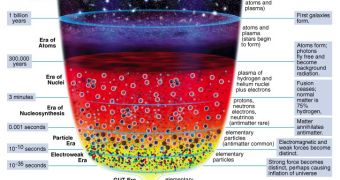The term Big Bang nucleosynthesis refers to the creation of the first nuclei during the early phases of the universe, shortly after the Big Bang. It is generally believed that in the minutes and hours after the Big Bang itself, besides the normal hydrogen, the heavier isotopes deuterium (D) and tritium (T) and the lithium isotopes Li-6 and Li-7 have been produced.
It's very important to understand the creation of these elements, as they are the first to be created in the earliest age of the Universe, coming long before the first creation of stable atoms in space and a good way of confronting theory with observations on the subject.
So far, theoretical predictions have pretty much come to the same results on the matter, especially with the help of recent high-precision maps of the cosmic microwave background and measurements of elemental abundances, which can also be used in other sciences, besides physics.
Still, one problem remains. It's the case of the original lithium, whose isotopes Li-6 and -7 can surprisingly be found in large quantities in metal-poor stars, which have very few heavier elements. For instance, an increased level of Li-6 could indicate a primordial origin of star, meaning that it wasn't created later in clusters or supernovae.
That would seem to contradict the Big Bang nucleosynthesis model. In a recent paper, Maxim Pospelov of the Perimeter Institute for Theoretical Physics in Waterloo, Ontario, and University of Victoria, British Columbia, claims to have found an explanation to the anomaly.
He stated that the actual original nucleosynthesis might have been catalyzed by the presence of charged heavy particles, which are common in many models of particle physics, particles that are suggested in supersymmetry theories.
In particle physics, supersymmetry (often abbreviated SUSY) is a symmetry that interchanges bosons and fermions. In supersymmetric theories, every fundamental fermion has a bosonic superpartner and vice versa.
The author says that charged SUSY particles long-lived enough (more than a thousand seconds) to survive into the BBN era would bind with light nuclei and enhance (by a factor as large as 10^8) the buildup to heavier nuclei before the SUSY particle itself would decay.
He hopes that this theory could be proved with the help of the Large Hadron Collider (LHC) now under construction in Geneva.

 14 DAY TRIAL //
14 DAY TRIAL //